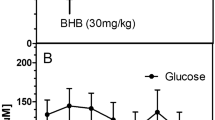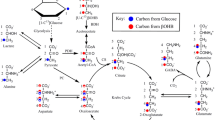Abstract
Excitotoxic neuronal death mediated by over-activation of glutamate receptors has been implicated in ischemia, hypoglycemia and some neurodegenerative diseases. It involves oxidative stress and is highly facilitated during impairment of energy metabolism. We have shown previously that in vivo systemic glycolysis inhibition with iodoacetate (IOA), exacerbates glutamate excitotoxicity. We have now investigated whether this effect involves oxidative damage to membrane lipids, as evaluated by the presence of thiobarbituric acid-reactive substances. We have also tested whether the ketone body, d-β-hydroxybutyrate (d-BHB), prevents lipoperoxidation and tissue damage. Results show that glutamate intrastriatal injection in control rats transiently enhances lipoperoxidation, while in IOA-treated animals increased lipoperoxidation is sustained. Treatment with d-BHB significantly reduces striatal lesions and lipoperoxidation. Vitamin E also reduced neuronal damage and lipoperoxidation. Results suggest that glycolysis impairment favors a pro-oxidant condition and situates oxidative damage as an important mediator of in vivo induced excitotoxicity. Results provide evidence for the neuroprotective effect of d-BHB against glutamate toxicity.



Similar content being viewed by others
References
Olney JW (1971) Glutamate-induced neuronal necrosis in the infant mouse hypothalamus. An electron microscopic study. J Neuropathol Exp Neurol 30:75–90
Choi D (1992) Excitotoxic cell death. J Neurobiol 23:1261–1276
Benveniste H, Drejer J, Schousboe A et al (1984) Elevation of extracellular concentrations of glutamate and aspartate in rat hippocampus during transient cerebral ischemia monitored by intracerebral microdialysis. J Neurochem 43:1368–1374
Sandberg M, Butcher S, Hagberg H (1986) Extracellular overflow of neuroactive amino acids during severe insulin-induced hypoglycemia: in vivo dialysis of the rat hippocampus. J Neurochem 47:178–184
Dawson L, Djali S, Gonzales C et al (2000) Characterization of transient focal ischemia-induced increases in extracellular glutamate and aspartate in spontaneously hypertensive rats. Brain Res Bull 53:767–776
Phillis J, Ren J, O’Regan M (2000) Transporter reversal as a mechanism of glutamate release from the ischemic rat cerebral cortex: studies with dl-threo-beta-benzyloxyaspartate. Brain Res 880:105–112
Seki Y, Feustel PJ, Keller RW Jr et al (1999) Inhibition of ischemia-induced glutamate release in rat striatum by dihydrokinate and an anion channel blocker. Stroke 30:433–440
Choi D (1988) Calcium-mediated neurotoxicity: relationship to specific channel types and role in ischemic damage. Trends Neurosci 11:464–469
Lafon-Cazal M, Pietri S, Culcasi M et al (1993) NMDA-dependent superoxide production and neurotoxicity. Nature 364:535–537
Bondy SC, Lee DK (1993) Oxidative stress induced by glutamate receptor agonists. Brain Res 610:229–233
Almeida A, Bolaños JP (2001) A transient inhibition of mitochondrial ATP synthesis by nitric oxide synthase activation triggered apoptosis in primary cortical neurons. J Neurochem 77:676–690
Atlante A, Calissano P, Bobba A et al (2001) Glutamate neurotoxicity, oxidative stress and mitochondria. FEBS Lett 497:1–5
Zeevalk GD, Nicklas WJ (1991) Mechanism underlying initiation of excitotoxicity associated with metabolic inhibition. J Pharmacol Exp Ther 257:870–878
Greene JC, Greenamyre JT (1996) Bioenergetics and glutamate excitotoxicity. Prog Neurobiol 48:613–634
Sánchez-Carbente M, Massieu L (1999) Transient inhibition of glutamate uptake in vivo induces neurodegeneration when energy metabolism is impaired. J Neurochem 72:129–138
Massieu L, Gómez-Román N, Montiel T (2000) In vivo potentiation of glutamate-mediated neuronal damage after chronic administration of the glycolysis inhibitor iodoacetate. Exp Neurol 165:257–267
Novelli A, Reilly JA, Lysko PG et al (1988) Glutamate becomes neurotoxic via N-methyl-d-aspartate receptor when intracellular energy levels are reduced. Brain Res 451:205–212
Henneberry RC (1989) The role of neuronal energy in the neurotoxicity of excitatory amino acids. Neurobiol Aging 10:611–613
García O, Massieu L (2001) Strategies for neuroprotection against l-trans-2,4-pyrrolidine dicarboxylate-induced neuronal damage during energy impairment in vitro. J Neurosci Res 64:418–428
Massieu L, Haces M, Montiel T, Hernández-Fonseca K (2003) Acetoacetate protects hippocampal neurons against glutamate-mediated neuronal damage during glycolysis inhibition. Neuroscience 120:365–378
Owen OE, Morgan AP, Kemp HG et al (1967) Brain metabolism during fasting. J Clin Invest 46:1589–1595
Sokoloff L (1973) Metabolism of ketone bodies by the brain. Annu Rev Med 24:271–280
Gjedde A, Crone CH (1975) Induction processes in blood–brain transfer of ketone bodies during starvation. Am J Physiol 229:1165–1169
Guzmán M, Blázquez C (2001) Is there an astrocyte-neuron ketone body shuttle. Trends Endocrinol Metab 12:169–173
Pollay M, Stevens A (1980) Starvation-induced changes in transport of ketone bodies across the blood–brain barrier. J Neurosci Res 5:163–172
Kirsch JR, D’Alecy LG (1984) Hypoxia induced preferential ketone utilization by rat brain slices. Stroke 15:319–323
Hawkins RA, Mans AM, Davis DW (1986) Regional ketone body utilization by rat brain in starvation and diabetes. Am J Physiol 250:E169–E178
Nehlig A (1996) Respective roles of glucose and ketone bodies as substrates for cerebral energy metabolism in the suckling rat. Dev Neurosci 18:426–433
Hori A, Tandon O, Holmes GL et al (1997) Ketogenic diet: effects on expression of kindled seizures and behavior in adult rats. Epilepsia 38:750–758
Bough KJ, Yao SG, Eagles DA (2000) Higher ketogenic diet ratios confer protection from seizures without neurotoxicity. Epilepsy Res 38:15–25
Yudkoff M, Daikhin Y, Nissim I et al (2001) Ketogenic diet, amino acid metabolism, and seizure control. J Neurosci Res 66:931–940
Freeman JM, Vining EPG, Pillas DJ et al (1998) The efficacy of the ketogenic diet—1998. A prospective evaluation of intervention in 150 children. Pediatrics 102:1358–1363
Izumi Y, Ishii K, Katsuki H et al (1998) Beta-hydroxybutyrate fuels synaptic function during development. Histological and physiological evidence in rat hippocampal slices. J Clin Invest 101:1121–1132
Masuda R, Monahan J, Kashiwaya Y (2005) d-beta-Hydroxybutyrate is neuroprotective against hypoxia in serum-free hippocampal primary cultures. J Neurosci Res 80:501–509
Noh HS, Hah Y-S, Nilufar R et al (2006) Acetoacetate protects neuronal cells from oxidative glutamate toxicity. J Neurosci Res 83:702–709
Suzuki M, Suzuki M, Sato K et al (2001) Effect of β-hydroxybutyrate, a cerebral function improving agent, on cerebral hypoxia, anoxia and ischemia in mice and rats. Jpn J Pharmacol 87:143–150
Suzuki M, Suzuki M, Kitamura Y et al (2002) β-Hydroxybutyrate, a cerebral function improving agent, protects rat brain against ischemic damage caused by permanent and transient focal cerebral ischemia. Jpn J Pharmacol 89:36–43
Tieu K, Perier C, Caspersen C et al (2003) d-β-Hydroxybutyrate rescues mitochondrial respiration and mitigates features of Parkinson disease. J Clin Invest 112:892–901
Montiel T, Quiroz-Baez R, Massieu L et al (2006) Role of oxidative stress on β-amyloid neurotoxicity elicited during impairment of energy metabolism in the hippocampus. Protection by antioxidants. Exp Neurol 200:496–508
Matthews RT, Ferrante RJ, Jenkins BG et al (1997) Iodoacetate produces striatal excitotoxic lesions. J Neurochem 69:285–289
Paxinos G, Watson C (1986) The rat brain in stereotaxic coordinates. Academic Press, Sidney
Ikemoto A, Bole DG, Ueda T (2003) Glycolysis and glutamate accumulation into synaptic vesicles. Role of glyceraldehyde phosphate dehydrogenase and 3-phosphoglycerate kinase. J Biol Chem 278:5929–5940
Delaney SM, Geiger JD (1996) Brain regional levels of adenosine and adenosine nucleotides in rats killed by high-energy focused microwave irradiation. J Neurosci Methods 64:151–156
Matthews RT, Yang L, Jenkins BG et al (1998) Neuroprotective effect of creatine and cyclocreatine in animal models of Huntington’s disease. J Neurosci 18:156–163
Gluck M, Jayatilleke E, Shaw S et al (2000) CNS oxidative stress associated with the kainic acid rodent model of experimental epilepsy. Epilepsy Res 39:63–71
Bradford MM (1976) A rapid and sensitive method for the quantitation of microgram quantities of protein utilizing the principle of protein-dye binding. Anal Biochem 72:248–254
Arias C, Montiel T, Quiroz-Baez R, Massieu L (2002) β-Amyloid neurotoxicity is exacerbated during glycolysis inhibition and mitochondrial impairment in the rat hippocampus in vivo and in isolated nerve terminals: implications for Alzheimer’s disease. Exp Neurol 176:163–174
Coyle JT, Puttfarcken P (1993) Oxidative stress, glutamate and neurodegenerative disorders. Science 262:689–695
Hammer B, Parker WD, Bennet JP (1993) NMDA receptors increase OH radicals in vivo by using nitric oxide synthase and protein kinase C. Neuroreport 5:72–74
Phillis JW, Clough-Helfman C (1990) Protection from cerebral ischemic injury in gerbils with the spin trap agent N-tert-butyl-alpha-phenylnitrone (PBN). Neurosci Lett 116:315–319
Schulz JB, Henshaw DR, Siwek D et al (1995) Involvement of free radicals in excitotoxicity in vivo. J Neurochem 64:2239–2247
Dykens JA, Stern A, Trenkner E (1987) Mechanism of kainate toxicity to cerebellar neurons in vitro is analogous to reperfusion tissue injury. J Neurochem 49:1222–1228
Dawson VL, Dawson TM, London ED et al (1991) Nitric oxide mediates glutamate neurotoxicity in primary cortical cultures. Proc Natl Acad Sci USA 88:6368–6371
Bolaños JP, Almeida A (1999) Roles of nitric oxide in brain hypoxia–ischemia. Biochem Biophys Acta 1411:415–436
Uto A, Dux E, Kusumoto M et al (1995) Delayed neuronal death after brief histotoxic hypoxia in vitro. J Neurochem 64:2185–2191
Rego AC, Santos MS, Oliveira CR (1999) Influence of the antioxidants vitamin E and idebenone on retinal cell injury mediated by chemical ischemia, hypoglycemia, or oxidative stress. Free Radic Biol Med 26:1405–1417
Malcolm CS, Benwell KR, Lamb H et al (2000) Characterization of iodoacetate-mediated neurotoxicity in vitro using primary cultures of rat cerebellar granule cells. Free Radic Biol Med 28:102–107
Kahlert S, Reiser G (2000) Requirement of glycolytic and mitochondrial energy supply for loading of Ca2+ stores and InsP3-mediated Ca2+ signaling in rat hippocampus astrocytes. J Neurosci Res 61:409–420
Hernández-Fonseca K, Massieu L (2005) Disruption of endoplasmic reticulum calcium stores is involved in neuronal death induced by glycolysis inhibition in cultured hippocampal neurons. J Neurosci Res 82:196–205
Ankarcrona M, Dypbukt JM, Bonfoco E et al (1995) Glutamate-induced neuronal death: a succession of necrosis or apoptosis depending on mitochondrial function. Neuron 15:961–973
Rego AC, Areias FM, Santos MS, Oliveira CR (1999) Distinct glycolysis inhibitors determine retinal cell sensitivity to glutamate-mediated injury. Neurochem Res 24:351–358
Kashiwaya Y, Takeshima T, Mori N et al (2000) d-β-Hydroxybutyrate protects neurons in models of Alzheimer’s and Parkinson’s disease. Proc Natl Acad Sci USA 97:5440–5444
Wada H, Okada Y, Nabetani M et al (1997) The effects of lactate and β-hydroxybutyrate on the energy metabolism and neural activity of hippocampal slices from adult and immature rat. Brain Res Dev Brain Res 101:1–7
Marie C, Bralet AM, Gueldry S et al (1990) Fasting prior to transient cerebral ischemia reduces delayed neuronal necrosis. Metab Brain Dis 5:65–75
Noh HS, Kim YS, Lee HP et al (2003) The protective effect of a ketogenic diet on kainic acid-induced hippocampal cell death in the male ICR mice. Epilepsy Res 53:119–128
Miyamoto M, Murphy T, Schnaar RL et al (1989) Antioxidants protect against glutamate-induced cytotoxicity in a neuronal cell line. J Pharmacol Exp Ther 250:1132–1140
Himi I, Ikeda M, Yasuhara T et al (2003) Role of neuronal glutamate transporter in the cysteine uptake and intracellular glutathione levels in cultured neurons. J Neural Transm 110:1337–1348
Ziegler DR, Ribeiro LC, Hagenn M et al (2003) Ketogenic diet increases glutathione peroxidase activity in rat hippocampus. Neurochem Res 28:1793–1797
Veech RL, Chance B, Kashiwaya Y (2001) Ketones bodies, potential therapeutic uses. IUBMB Life 51:241–247
Acknowledgments
This study was supported by 40306-M CONACYT and IN222503 PAPIIT UNAM grants to LM and CONACYT and DGEP-UNAM fellowships to JM.
Author information
Authors and Affiliations
Corresponding author
Rights and permissions
About this article
Cite this article
Mejía-Toiber, J., Montiel, T. & Massieu, L. d-β-Hydroxybutyrate Prevents Glutamate-Mediated Lipoperoxidation and Neuronal Damage Elicited during Glycolysis Inhibition In Vivo. Neurochem Res 31, 1399–1408 (2006). https://doi.org/10.1007/s11064-006-9189-5
Received:
Accepted:
Published:
Issue Date:
DOI: https://doi.org/10.1007/s11064-006-9189-5




